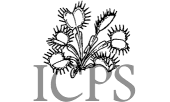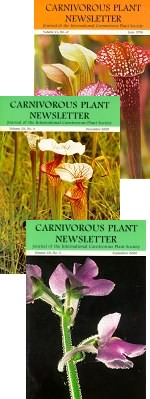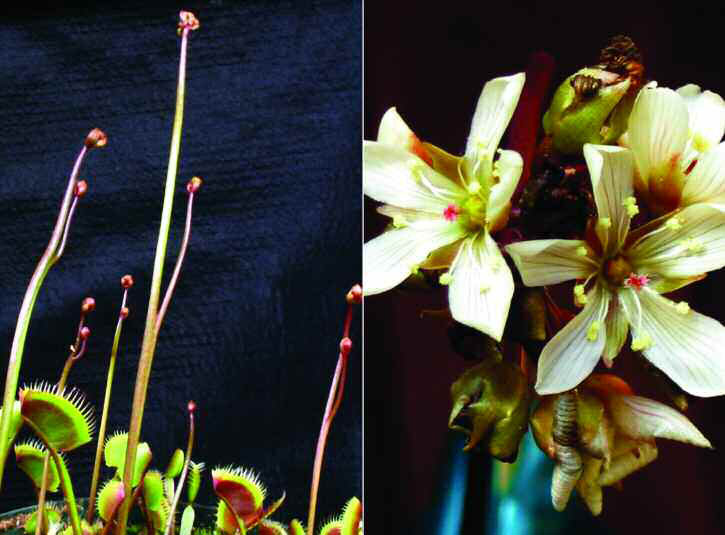
|
| Cultivar Registrations in CPN |
|
Carnivorous Plant Newsletter New Cultivars Keywords: cultivar: Dionaea muscipula ‘Petite Dragon’, Sarracenia flava ‘Suspicion’, Sarracenia alata ‘Night.Submitted: 16 February 2006 While visiting California Carnivores in 1999, Peter D’Amato gave me a small offshoot from a plant labeled Dionaea ‘Red Dragon’ (also known as Dionaea ‘Akai Ryu’). Although I had been growing flytraps since 1955, this was my first Dionaea cultivar. Over the subsequent six years, the plant divided numerous times and now I have many individual plants of that clone. Since my initial introduction to Dionaea cultivars, I have developed a hobby of comparing cultivars under similar growing conditions, including Dionaea ‘Akai Ryu.’ It soon became apparent that the plant that I received from Peter was not the true Dionaea ‘Akai Ryu.’ In fact, the plant was so different that on February 9, 2006 I decided it should be given a cultivar name, and selected the name Dionaea ‘Petite Dragon’. Whereas Dionaea ‘Akai Ryu’ is described in Carnivorous Plant Newsletter 25(2):50 as “far superior to any of the parents in terms of growth rate and vigor,” and that “growth habit and flower morphology are typical for this species,” Dionaea ‘Petite Dragon’ remains the smallest plant (even as a 6-year-old flowering adult) of any flytrap that I have grown in 50 years. Grown outside in full sun, a mature Dionaea ‘Petite Dragon’ trap is typically 15 mm long, with the largest attaining 17 mm (see Figure 1). The rosette diameter of mature plants is about 6 cm and rarely exceeds 10 cm in spring. The flower scape is about 12 cm tall and always bifurcates into two flower clusters, a large and small one (see Figure 2). The flowers have a red stigma. This is the only clone of the 61 “named” clones (i.e. plants with cultivar names, or other informal grower-given appellations) that I presently grow in which the flower scape bifurcates regularly. I have selfed this plant over several years and all of the offspring grow into small adults having bifurcated flower scapes. This plant and its seed offspring are all red like Dionaea ‘Akai Ryu’, and the stigma is red as in many other all-red Dionaea clones. This plant will principally be of interest to those that study the genetic diversity of Dionaea muscipula. Those that seek giant specimens will perhaps conclude that Dionaea ‘Petite Dragon,’ to quote a well-known critic, “only merits the trash can because it is a crappy grower.” However, some growers may be interested in miniature rather than giant flytraps. Etymology: This clone is herein described as Dionaea muscipula ‘Petite Dragon,’ because it suggests a small Dionaea ‘Akai Ryu.’ Although the plant produces fertile seed when selfed and all of the seedlings are red like the parent and the offspring retain this double scape, the preferred method of propagating it is by vegetative means to preserve the genetic integrity. —ROBERT ZIEMER • McKinleyville, CA • USA
Figure 1: Dionaea muscipula ‘Petite Dragon’ growing outdoors in an artificial bog— spring rosettes are 6 cm in diameter.
Figure 2: Dionaea muscipula ‘Petite Dragon’: bifurcated flower scapes in spring before greenhouse-grown plants have attained full red coloration (left), and flowers with red stigmas (right) Submitted: 9 February 2007 At first glance, Sarracenia ‘Suspicion’ (see Front Cover) may appear to be a clone of Sarracenia flava var. maxima. On closer inspection the plant is revealed to be in fact an anthocyanin-free Sarracenia flava clone that is wholly devoid of any anthocyanin induced red colouration, even when grown under conditions of intense, direct sunshine. There is no red colouration evident in any parts of the plant, including cladophylls and rhizome. Nor does the plant display spots of red discolouration when damaged, as is normally the case in Sarracenia. The slim and elegant pitchers are a bright, apple green when fresh, slowly fading to a lemon yellow by the end of the growing season. The sulphur-yellow flower with the usual musty perfume is entirely typical for the species. Resulting from the self-pollination of a Sarracenia flava clone acquired from Adrian Slack, Sarracenia ‘Suspicion’ was raised from seed in 1989 by UK grower Stephen Locke. Unlike some anthocyanin-free Sarracenia variants, Sarracenia ‘Suspicion’ has proved to be quite vigorous in cultivation. The derivation of the name Sarracenia ‘Suspicion’ is as an allusion to envy, which is often signified by the colour green. The cultivar name was coined on February 8th, 2007. In order to maintain the unique characteristics of the plant, reproduction must be achieved by vegetative methods only. —AIDAN M. SELWYN • Holybourne • Alton • Hampshire • GU34 4EH • United Kingdom
Front Cover: The new cultivar Sarracenia ‘Suspicion’. Photograph by Aidan Selwyn. Submitted: 1 June 2006 This plant was selected as the best plant from a large batch of seedlings. The seed source was the ICPS seed bank and the reported collection location was “Stone County, Mississippi.” The seedlings were raised at the Botanical Conservatory at the University of California, Davis by John Brittnacher, and accessioned into the collection in 2002. Other seedlings from this batch of seeds were also impressively red-colored S. alata. Sarracenia alata ‘Night’ is a tall and vigorous clone (see Figure 3). At the time of description (and photograph), the tallest pitcher was 74 cm high (29”), which makes it the tallest of the S. alata plants at the Botanical Conservatory at the University of California, Davis. The underside of the hood and pitcher throat are effectively black in mature pitchers, and the exterior of the upper third of the pitcher tube is deep red. This clone produces copious amounts of nectar on the pitcher column, and in sunlight the droplets sparkle against the black throat giving the impression of stars twinkling in the night sky, which provided the inspiration for the cultivar name. I coined the cultivar name in April, 2006. This clone has other interesting features as well. The base of the pitcher is blood red, and the top side of the hood is red and yellow with pronounced red venation. The contrast between the reticulated red venation is far greater than the upper pitcher. The pitcher tube constricts just below the mouth of the pitcher. The entire time we have grown this plant, the pitcher coloration of the pitchers has been stable. Young pitchers start as a light lime-green with red venation. The coloration spreads from the veins to the webbing of the pitcher as the pitcher matures, until the overall red color is achieved. The pitchers become dark red, and the throats blacken, about 2-3 weeks after the pitchers open. As with many red-colored Sarracenia, this plant requires high light levels and high humidity to develop and maintain the red coloration. Small plants (<7.5 cm high) do not develop the deep red colors but the venation is redder and more pronounced than typical S. alata plants. The flowers of this clone are typical for S. alata, which confirms that this plant has not achieved its exceptional coloration through hybridization or introgression. The petals are cream colored and rounded. The sepals are light cream to yellow. The rhizome readily forms lateral branches, which aids in propagation. This clone should only be propagated by vegetative means to maintain both the details of the dark red and black coloration on the pitchers and the high vigor of this selection. The nomenclature of the red forms of S. alata is rather vague. Don Schnell (2002) mentions red S. alata plants, but he does not establish a name for them at the variety or from rank. Peter D’Amato (1998) mentions plants, using the descriptor “nigrapurpurea,” to indicate specimens that have dark red or nearly black pitcher lid undersides. This term should be avoided since it has never been formally described, but the characteristics of S. alata ‘Night’ would appear to be similar, if not identical. References: —THOMAS CAHILL • Phoenix, AZ • USA
Figure 3: Sarracenia ‘Night’ The plant pictured was grown in a very bright greenhouse in Davis, CA. |
This page is maintained by Robert Ziemer, |





